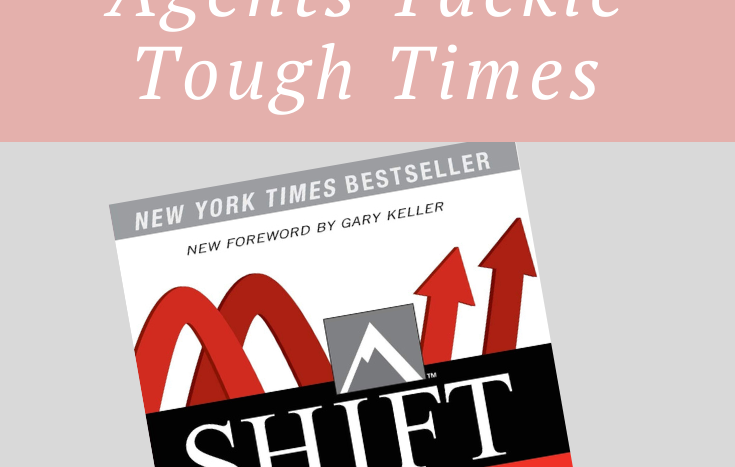In Shift: How Top Real Estate Agents Tackle Tough Times, Gary Keller, Dave Jenkins, and Jay Papasan provide 12 tactics for getting your real estate business through a recession. Originally published during the Great Recession in 2009, is this book still relevant to today’s real estate agents?
As you’re well aware, COVID-19 has pushed us all into the next recession a bit earlier than expected. And now it’s time to make some recession-proofing changes to your real estate business. Many agents are wondering if this recession will be like the last. And just how much of Shift will apply to this recession more than a decade after the book was written?
As someone who read Shift immediately upon publication and re-read it just this week…I have thoughts. Here’s my real estate book review of Shift: How Top Real Estate Agents Tackle Tough Times.
Real Estate Book Review – Shift: How Top Real Estate Agents Tackle Tough Times

How Shift is Structured
I get truly excited about well-organized non-fiction, so I appreciate that Shift is logically structured. The bulk of the book is divided into 12 tactics for surviving a down market:
1. Get Real, Get Right – Mindset and Action
This is a quick intro about mentally preparing to make the necessary changes to your business. Nothing revolutionary, but a solid way to ease into the rest of the tactics.
2. Re-Margin Your Business – Expense Management
Shift’s take on expense management during a slow market is to reduce your expenses as much as possible to protect your profit margins. And any dollars you do put to work should be tracked to make sure the expenditure is worth it. Good start, but I wish this section had been a bit more detailed.
For example, not everyone knows how to calculate and track the ROI of business expenses. That would be helpful. A discussion about the benefits of increasing marketing expenses would also have been useful. After all, when other agents panic and pull back their marketing budget, increasing your budget by just a bit can earn you a disproportionate market share in the advertising space since you have less competition.
3. Do More with Less – Leverage
This short chapter on leverage is largely about leveraging your personnel. If you don’t have a team of buyer’s agents, admin, and transaction coordinators, there isn’t much here that will apply to you. But there are some important notes about leveraging loan officers, title reps, and escrow officers that apply to everyone.
4. Find the Motivated – Lead Generation
This is where Shift starts providing real value via detailed advice. There are lists of ways to prospect and market, tips about scheduling your lead-generation time, and strategies for making your message resonate with prospective buyers and sellers. My only issue with this chapter is that it isn’t recession-specific. New agents will be able to take a lot away from this chapter, but veteran agents should be well aware of these general lead-generation strategies.
5. Get to the Table – Lead Conversion
The 3 C’s of Lead Conversion: Capture, Connect, and Close. This chapter does a deep dive on how to connect with prospects and how to close them, even getting into 10 classic closes you can choose from. Again, this is helpful information for new salespeople, but nothing new for experienced agents.
6. Catch People in Your Web – Internet Lead Conversion
This chapter on Internet lead conversions holds up surprisingly well, given the tech advancements of the last decade. Good for Shift for recognizing the importance of real estate agent websites way back then! Your broker’s site only promotes your brokerage; for effective Internet lead conversion, you need your own website. Luckily, getting a website of your own is now easier and more cost-effective than ever. With so many website-building tools available, even non-techies can build their own professional websites for a fraction of the cost of hiring a web designer.
This chapter gets into online consumer behavior, website elements, and lead funnels, all of which are still relevant today. The tools used to operate these functions of your website may have changed, but the functions themselves remain the same.
Of course it’s lacking modern specifics like social media marketing, blogging for organic Google traffic, and monetizing your website, but that’s to be expected.
7. Price Ahead of the Market – Seller Pricing Strategies
This is one of my favorite chapters in Shift! Seller pricing strategies are largely common sense, but it’s difficult to help your sellers see the logic when they’re so fueled by emotion. This chapter gives you specific tactics for working with the sellers to establish a listing price. And it’s full of figures and diagrams that make the complex financial models easy to understand at-a-glance.
8. Stand Out from the Competition – Seller Staging Strategies
A chapter on staging. Even new agents should know all of the information presented in this chapter. But, if some of the terrible listing photos I’ve seen are an indication of staging quality, perhaps some agents should pay close attention to this chapter.
9. Create Urgency – Overcoming Buyer Reluctance
Just like the chapter on seller pricing strategies, this chapter on working with buyers is impressive! Full of useful diagrams and loose scripts, this chapter will help you get your buyer clients over the hurdle and onto the property ladder.
10. Expand the Options – Creative Financing
I appreciate this chapter on creative financing because too few agents address financing head-on. Most simply refer clients to their lender and leave it at that. But savvy agents know that it’s their responsibility to understand real estate financing and be able to come up with creative financing solutions to get deals closed. Of course you’re always going to rely on the lender to advise your clients on financing. But you need to be able to answer financing questions and find opportunities for your clients to get deals done in a slow economy.
11. Master the Market of the Moment – Short Sales, Foreclosures, and REOs
2008-2012 was all about short sales, foreclosures, and REOs. And this chapter gives a good overview of the foreclosure process as well as working with clients through each stage of the process.
12 Bulletproof the Transaction – Issues and Solutions
Shift’s final chapter provides more back-to-basics instruction, focusing on the escrow process. There is a lot of solid, practical advice about working through inspection, appraisal, and contingency issues. But unless you’re brand new to real estate, everything in this chapter should be business-as-usual to you.
Is Shift Still Relevant in 2020 and Beyond?
Shift holds up surprisingly well considering the many ways the world has changed since 2009. Even the chapter on Internet leads is (shockingly!) still largely relevant.
Much of the book is about getting back to basics and working efficiently to maximize every lead, all of which is still critical today.
Having said that, the 2020 recession will likely be different from the 2008 recession. You’ll recall that recession started in the mortgage market, meaning real estate was essentially ground zero. This recession, on the other hand, started with a pandemic that closed small businesses and put millions of people out of work. So real estate will be slower to be impacted. And we likely won’t see as many foreclosures this time around since few people have over-leveraged their real estate holdings. Now, there will still be many more short sales and foreclosures than we’ve seen in the strong economy, just not as many as during the Great Recession.
As mentioned, some tech advancements have also created new opportunities for real estate lead-generation, which naturally aren’t covered in this 2009 book.
What I Love About Shift
Again, I love that there is a clear and logical structure to Shift. I also love some of the visual representations. The “Cost of Overpricing” figures in Tactic #7 are especially impactful. The layout of a book is underappreciated, but truly difficult to get right, so kudos to the authors for nailing the presentation.
I also love that there are concrete tactics presented. Shift isn’t all about nebulous mindset concepts. There is actionable advice that will move your business forward if you just follow it.
And because so much of the book is about getting back to basics, it holds up well after all these years. New agents will find this book especially useful since it covers general marketing, lead-conversion, and transaction coordination strategies.
Areas That Could Be Improved
Shift can be a bit repetitive and contains too much fluff for my liking. Markets are cyclical – got it. You need to shift – got it. These things really only need to be said once, but they are repeated countless times.
Of course Shift is also missing chapters on newer lead generation methods we now enjoy thanks to tech advances, but we can hardly fault the 2009 book for that.
Here’s my biggest issue with Shift: the whole book is about surviving the recession, with very little emphasis on using the circumstances to grow your business. I wish Shift would have focused more on the opportunities made available to real estate agents in struggling markets.
Yes, Shift talks about taking advantage of short sales and REOs. But what about:
- investors who are always looking for killer deals in a down market?
- renters who can get a lower-than-normal price and interest rate on a starter home?
- upgraders who can save more money buying a fancy house at lower rates than they’d lose on the sale of their current house?
- expired listings, which often increase in a down market?
There’s also zero mention of recession-proof income streams in Shift.
A recession is the perfect time to add a recession-friendly service to your real estate business (think credit repair, property management, or property tax appeals). Not only will this diversify your income so you don’t have to rely 100% on commission from closing, but it also gives you a chance to cross-promote your different service offerings while providing a much-needed service to your client base. And as long as your new income stream is based in real estate, you’re enhancing your brand (rather than watering it down).
You can also build passive income streams through real estate investments of your own or by monetizing your real estate website.
There are far more opportunities in slow markets than most agents realize. That’s why I wrote The Recession-Proof Real Estate Agent: How Savvy Agents are Finding New Opportunities in Slow Markets. If you want to thrive during the recession, instead of just surviving it, this book is full of actionable strategies for growing your business in a down market. You can get your copy directly from my Etsy shop for a limited time.
Final Score
I’m giving Shift a 7 out of 10.
The basics are all solid, and Shift won’t steer you wrong. It remains surprisingly relevant, offering actionable information for navigating a declining market.
But focusing on surviving the recession instead of taking advantage of opportunities to grow your business through the recession is where Shift loses points.
I still believe Shift is required reading, especially for newer agents who may not yet have a strong real estate foundation. But I recommend supplementing it with something like The Recession-Proof Real Estate Agent. This book offers a complete step-by-step guide to recession-proofing your real estate business.
Order your copy of Shift: How Top Real Estate Agents Tackle Tough Times and/or The Recession-Proof Real Estate Agent on Amazon today!
Do You Agree?
If you’ve recently read Shift: How Top Real Estate Agents Tackle Tough Times, I’d love to get your opinion. Do you agree with my review? What did you think of the book? Let me know in the comments.









